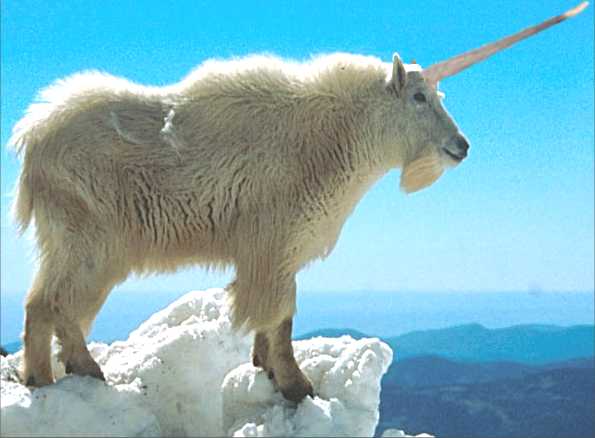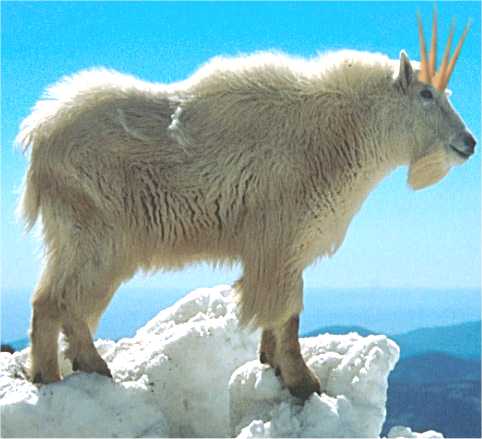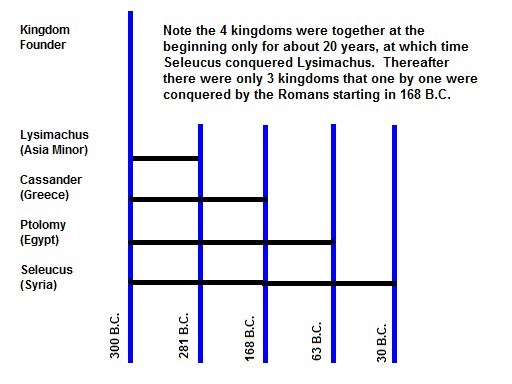Explanation of the Goat of Daniel 8
Interpretation Principles -
Single horn replaced by four horns indicates 4 kingdoms follow an initial single
kingdom, a horn is equivalent to a head which is equivalent to the body of a beast
in terms of what each symbolizes (Equivalency Principle), Similarity Principle,
Difference Principle, Characteristics Principle. For more information about
the principles mentioned here and below, see
Rules of Interpretation of Daniel and Revelation
.
One horn being replaced with 4 horns represented the fact that one kingdom was divided
into 4 kingdoms. It really is that simple. And history shows that this
did happen with the Greek Kingdom of Alexander the Great.
 ⇒
⇒

Goat with one horn becomes a goat with 4 horns
Prophetic time always moves forward.
![]()
This arrow takes you to the next beast of Daniel 7.
In Daniel 8 it said that the goat with the single horn represented the king of Greece,
with the single horn representing its first king. Alexander the Great was
the first king of his empire, and in fact was the only king of his empire of note.
After the goat had beaten the ram to the ground and it has risen to the peak of
its power, the prominent horn between its eyes broke off and 4 horns came up in
place of the first horn. This tells us that the first kingdom was replaced
by 4 kingdoms, so this indicates that when horns come up after other horns, the
second set of horns represents kingdoms that occur
after
the kingdom represented by the first set of horns.
The single horn of the goat is said by the angel to be the first king of Greece.
This is the same as what is represented by the body of the leopard in Daniel 7,
which tells us that a horn can take on the same symbolic meaning as the body of
a beast. Further, the 4 horns of the goat are clearly the same as the 4 heads
of the leopard. This is representative of what can be called the
Equivalency Principle,
which says that heads, horns, and bodies of beasts are all symbolic of the same
things, which is that they can represent a particular king or his name, the office
of the head of a kingdom (king), a kingdom, or an empire. The only difference
between the body of a beast and heads or horns is that heads and horns usually represent
kingdoms that arise from the original kingdom (ram and goat show exceptions to this).
The body of a beast normally represents the initial kingdom or empire.
In the vision of Daniel 8, Daniel saw the goat arriving with such speed that his
feet did not touch the ground, sort of like what is portrayed with some cartoon
characters on television. This was done to represent the great speed with
which Alexander the Great conquered other kingdoms and built his empire, but in
particular it was representing its attack against Medo-Persia. The goat is
shown to totally defeat the ram, and in fact that is what happened in history as
well.
The single horn being prominent on the goat and the great speed with which he arrived
would suggest the aggressive nature of Alexander the Great. The great speed
of arrival and the prominence of the horn are secondary characteristics (something
about a beast other than just the mere
presence
of its body, heads, or horns) of this beast used to describe its behavior. This
illustrates what is called the
Characteristics Principle,
where "extras" such as wings, ribs in a beast's mouth, colors, or other
secondary characteristics help us understand the behavior of a kingdom or something
in particular that it would do, or how it would do something. The 3 ribs in
the bear's mouth for Medo-Persia would be another example of the
Characteristics Principle,
Why a Goat to represent Greece and a Ram for Medo-Persia?
Why a goat to represent Greece (or Macedonia)? A goat is more aggressive than a
sheep. The curved back horns typical of a ram could suggest the less aggressive
nature of the ram compared to the goat, which had a horn between the eyes, which probably
means there was a forward projecting horn that in turn suggests a more aggressive behavior
on the part of the goat. History bears this out. Alexander the Great
demonstrated aggressiveness in his battles, tactics, and conquests. Comparatively,
the Persians were less aggressive compared to Alexander the Great, though it is also true
that they often showed up for battles with huge armies. Of course, with a huge army,
the risk to any one individual soldier would likely be diluted. If you doubt that
Alexander was the more aggressive leader, consider that he conquered much of the then known
world in just a few years. This gets back to the behavior of these kingdoms and how
the animals chosen to represent them demonstrate behaviors of these kingdoms. This
is God using the
Characteristics Principle
to explain something about each of these kingdoms. Here, consider that God
is using the goat and ram to contrast the different aggressive behaviors of the
two empires. A goat and ram are not predators, so their use is not likely
to demonstrate attack methods because they don't hunt to kill as a predator does.
The Persians, under Darius, may have set the stage for the rise of Alexander the
Great in a way because they invaded Greece in
512 B.C.
and took it over. The Greeks fought back and eventually drove the Persians
from their soil in
479 B.C.
There were some battles back and forth between these powers over time until Alexander the
Great finally finished off the Persian Empire. We'll never know, but is it possible
that Alexander the Great would not have gone out to conquer the world had the Persians
not invaded Greece originally? Even though Alexander the Great was Macedonian,
the invasions or the threat of invasions by the Persians made them a threat to him
and his kingdom. Of course, he might have anyway, but the Persians may
have given him an excuse. For more brief information about ancient Greek history,
see
the ancient Greek history timeline.
Historians say that Persia was intent on invading Europe eventually, but Greece stopped
them. One wonders what history would have been had that not happened?
History
After Alexander the Great died,
his half brother took the throne.
But he was mentally unstable and considered unfit to rule. Eventually, Greek military
generals fought among themselves for the empire, but finally divided it and parted
ways. There were seven top military commanders of Alexander the Great who initially
fought among themselves for the empire, but in the end, only four got anything. The
seven have often been called the Diodachi.
The four generals and the territories they took over from Alexander the Great after
his death were: Cassander, who took Greece and Macedonia, Lysimachus, who took Asia-minor,
Thrace,
Bithynia,
and
Pergamum;
Ptolemy, who took Egypt, Libya, and Palestine; and Seleucus, who took over Asia Minor,
Syria, and Persia, which included Babylon. This four way split in the kingdom was
complete by
300 B.C.
There were three large divisions and a smaller one, but this situation didn't last
long. In
281 B.C,
Seleucus attacked the kingdom ruled by
Lysimachus
and defeated it. Thereafter, there were three kingdoms, with only two playing much
part in the history around Palestine, Seleucus in the north and the Ptolomies in
the south. Cassander's kingdom was still around but was in Greece and Macedonia
and largely out of the picture. The battles between the generals is called
the Diodachi Wars.
Look here if you would like to read more of the history of the Diodach Wars.
Here is yet another short but very readable history of the main points of the Diodach
Wars
.
Here are links that provide a chronology of each empire:
The Seleucid (Hellenistic) empire.
(Look for Middle East part way down the home page, then find just below that the Kings Lists and click on that. Look for Syria on the left part way down the page, and then click on Seleucid (Hellenic) Empire in the right column.)
The
The Ptolomy (Hellenistic) empire,
(Scroll down to just below GRECO-ROMAN PERIOD)
The Macedonia (Hellenistic) empire
Click here to view the online museum from the University of Pennsylvania on Ancient
Greece
Look at the links below to see biographical information about each person:
Click here to see a map of the 4 kingdoms after they were split from Alexander the
Great's kingdom.
Note that this map may take a little time to load as it is about 339K in size.
Note that in the graph below showing the fall dates of the four kingdoms, the time
line is not proportional to real time. It is for illustration purposes to
show which kingdoms fell and when. Note that there were four kingdoms that existed
together for about twenty years beginning in
300 B.C.
Thereafter there were only three kingdoms.

One thing that is of note is that historians in relatively recent times (last 200 years),
considered Macedonia as part of Greece. They counted four provinces of Greece which
were Macedonia, Epirus, Achaia, and Peleponnesus. However, Macedonia has a history
all its own, so more recent historians consider Macedonia to have been a separate
nation. Therefore, Macedonia conquered Greece, then went on to conquer much of the
rest of the world to the south and east of Greece and Macedonia. This did spread
Greek culture throughout the Middle East, so it probably is not improper to consider this
empire to be Greek in its effects on much of the world it conquered. In Daniel 8,
the empire is referred to as Greek because it is said that the horn on the goat
represented the king of Greece, which Alexander the Great certainly was. Of course,
he became king of a lot of other countries before he was done.
There is another aspect to this question. Alexander was taught by Arisotle, which
gave him a Greek education. One result of that was that Alexander the Great adopted
a Greek way of life. So, it is natural that Alexander would have spread Greek culture
throughout the regions that he conquered. Therefore, it is not unreasonable to refer
to this kingdom as Greek because of its origins from both Macedonia and Greece, but also
because of its effects upon other kingdoms in bringing in a Greek influence.
The single horn of the one-horned goat is obviously representative of the same thing
that the body of the leopard with four heads and four wings represents, which is the empire
of Alexander the Great before he died. The four horns of the four-horned goat is
clearly representative of the same thing as the four heads of the four headed leopard,
which is the four kingdoms the empire were split into after Alexander the Great died.
Therefore, you could say that the one horn on the goat is equivalent to one leopard body,
and four horns on the goat are equivalent to four heads on the leopard. We can
generalize to say that heads, horns, and the body of beasts all can represent the names of
leaders of nations, empires, kingdoms, kings, or power. This is the basis of the
Equivalency Principle,
which says that the body of a beast is equivalent in it's function as a symbol to
heads or horns (they CAN represent the exact same things). However, there
are slight differences between the body and the heads or horns, though they are
functionally equivalent as symbols.
The body of beasts usually represents kingdoms, empires, nations, or powers that
have not arisen from the breakup of a previously existing kingdom. Heads and
horns normally represent the product of breakup of a previously existing power.
The fact that heads and horns normally represent kingdoms that have split up is
the basis of the
Difference Principle,
which states that heads and horns always represent smaller, less powerful kingdoms
than the original empire. If horns are upon multiple heads, then horns could
be viewed as generally less powerful than heads because they are a further splitup
of the original kingdom. It also is the basis of the
Similarity Principle,
which says that split up kingdoms will have a like nature to the kingdom they came
from, which is to say that political kingdoms will usually be followed by political
kingdoms, and we could generalize further to say that religious kingdoms will usually
follow religious kingdoms, unless there is an exception stated. There also
is an
Exception Principle,
which says that where an exception is stated about a beast or one of its heads or
horns, from that point on down through history, the exception will be used
for that beast or head or horn or any powers emanating from it.